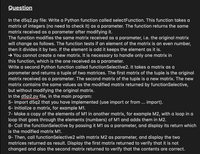
Database System Concepts
7th Edition
ISBN: 9780078022159
Author: Abraham Silberschatz Professor, Henry F. Korth, S. Sudarshan
Publisher: McGraw-Hill Education
expand_more
expand_more
format_list_bulleted
Question
Please help me with this question,
also respect the exemple please. Thank you

Transcribed Image Text:Question
In the d5q2.py file: Write a Python function called selectFunction. This function takes a
matrix of integers (no need to check it) as a parameter. The function returns the same
matrix received as a parameter after modifying it.
The function modifies the same matrix received as a parameter, i.e. the original matrix
will change as follows. The function tests if an element of the matrix is an even number,
then it divides it by two. If the element is odd it keeps the element as it is.
→ You cannot create a new matrix. It is necessary to handle only one matrix in
this function, which is the one received as a parameter.
Write a second Python function called functionSelective2. It takes a matrix as a
parameter and returns a tuple of two matrices. The first matrix of the tuple is the original
matrix received as a parameter. The second matrix of the tuple is a new matrix. The new
matrix contains the same values as the modified matrix returned by functionSelective,
but without modifying the original matrix.
In the d5p2.py file, in the main program:
5- Import d5q2 that you have implemented (use import or from ... import).
6- Initialize a matrix, for example M1.
7- Make a copy of the elements of M1 in another matrix, for example M2, with a loop in a
loop that goes through the elements (numbers) of M1 and adds them in M2.
8- Call the functionSelective by passing it M1 as a parameter, and display its return which
is the modified matrix M1.
9- Then, call functionSelective2 with matrix M2 as parameter, and display the two
matrices returned as result. Display the first matrix returned to verify that it is not
changed and also the second matrix returned to verify that the contents are correct.
![Example1:
The matrix is:
[[33, 20, 67], [8, 55, 90], [72, 38, 29]]
After execution of functionSelective, the matrix
is:
[[33, 10, 67], [4, 55, 45], [36, 19, 29]]
After execution of functionSelective2, the matrix
initial is:
[[33, 20, 67], [8, 55, 90], [72, 38, 29]]
A new matrix created with functionSelective2:
[[33, 10, 67], [4, 55, 45], [36, 19, 29]]](https://content.bartleby.com/qna-images/question/32c13ba7-237d-4629-8f55-05e99d86aab8/8cbcd73a-8b4e-4936-aa70-6a06bfa1e749/dyzjhl_thumbnail.png)
Transcribed Image Text:Example1:
The matrix is:
[[33, 20, 67], [8, 55, 90], [72, 38, 29]]
After execution of functionSelective, the matrix
is:
[[33, 10, 67], [4, 55, 45], [36, 19, 29]]
After execution of functionSelective2, the matrix
initial is:
[[33, 20, 67], [8, 55, 90], [72, 38, 29]]
A new matrix created with functionSelective2:
[[33, 10, 67], [4, 55, 45], [36, 19, 29]]
Expert Solution
This question has been solved!
Explore an expertly crafted, step-by-step solution for a thorough understanding of key concepts.
Step by stepSolved in 2 steps with 3 images

Knowledge Booster
Learn more about
Need a deep-dive on the concept behind this application? Look no further. Learn more about this topic, computer-science and related others by exploring similar questions and additional content below.Similar questions
arrow_back_ios
arrow_forward_ios
Recommended textbooks for you
 Database System ConceptsComputer ScienceISBN:9780078022159Author:Abraham Silberschatz Professor, Henry F. Korth, S. SudarshanPublisher:McGraw-Hill Education
Database System ConceptsComputer ScienceISBN:9780078022159Author:Abraham Silberschatz Professor, Henry F. Korth, S. SudarshanPublisher:McGraw-Hill Education Starting Out with Python (4th Edition)Computer ScienceISBN:9780134444321Author:Tony GaddisPublisher:PEARSON
Starting Out with Python (4th Edition)Computer ScienceISBN:9780134444321Author:Tony GaddisPublisher:PEARSON Digital Fundamentals (11th Edition)Computer ScienceISBN:9780132737968Author:Thomas L. FloydPublisher:PEARSON
Digital Fundamentals (11th Edition)Computer ScienceISBN:9780132737968Author:Thomas L. FloydPublisher:PEARSON C How to Program (8th Edition)Computer ScienceISBN:9780133976892Author:Paul J. Deitel, Harvey DeitelPublisher:PEARSON
C How to Program (8th Edition)Computer ScienceISBN:9780133976892Author:Paul J. Deitel, Harvey DeitelPublisher:PEARSON Database Systems: Design, Implementation, & Manag...Computer ScienceISBN:9781337627900Author:Carlos Coronel, Steven MorrisPublisher:Cengage Learning
Database Systems: Design, Implementation, & Manag...Computer ScienceISBN:9781337627900Author:Carlos Coronel, Steven MorrisPublisher:Cengage Learning Programmable Logic ControllersComputer ScienceISBN:9780073373843Author:Frank D. PetruzellaPublisher:McGraw-Hill Education
Programmable Logic ControllersComputer ScienceISBN:9780073373843Author:Frank D. PetruzellaPublisher:McGraw-Hill Education

Database System Concepts
Computer Science
ISBN:9780078022159
Author:Abraham Silberschatz Professor, Henry F. Korth, S. Sudarshan
Publisher:McGraw-Hill Education

Starting Out with Python (4th Edition)
Computer Science
ISBN:9780134444321
Author:Tony Gaddis
Publisher:PEARSON

Digital Fundamentals (11th Edition)
Computer Science
ISBN:9780132737968
Author:Thomas L. Floyd
Publisher:PEARSON

C How to Program (8th Edition)
Computer Science
ISBN:9780133976892
Author:Paul J. Deitel, Harvey Deitel
Publisher:PEARSON

Database Systems: Design, Implementation, & Manag...
Computer Science
ISBN:9781337627900
Author:Carlos Coronel, Steven Morris
Publisher:Cengage Learning

Programmable Logic Controllers
Computer Science
ISBN:9780073373843
Author:Frank D. Petruzella
Publisher:McGraw-Hill Education